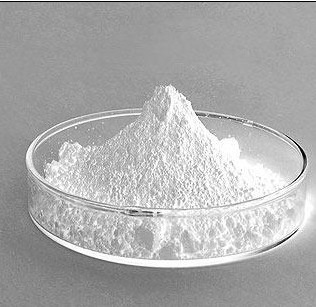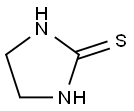에틸렌티오우레아
|
|
에틸렌티오우레아 속성
- 녹는점
- 196-200 °C(lit.)
- 밀도
- 1.41~1.45
- 벌크 밀도
- 750-900kg/m3
- 증기압
- <1 hPa (25 °C)
- 굴절률
- 1.5500 (estimate)
- 인화점
- 252 °C
- 저장 조건
- Store below +30°C.
- 용해도
- 8g/L
- 물리적 상태
- 가루
- 산도 계수 (pKa)
- 15.01±0.20(Predicted)
- 색상
- 하얀색
- 냄새
- 흰색에서 밝은 녹색 결정, 희미한 아민 냄새
- 생물학적 소스
- synthetic
- 수용성
- 19g/L(20℃)
- Merck
- 14,3803
- BRN
- 106275
- 끓는 점
- 240°C (1010 hPa)
- InChIKey
- PDQAZBWRQCGBEV-UHFFFAOYSA-N
- LogP
- -0.67 at 20℃
- CAS 데이터베이스
- 96-45-7(CAS DataBase Reference)
- IARC
- 3 (Vol. Sup 7, 79) 2001
안전
- 위험 및 안전 성명
- 위험 및 사전주의 사항 (GHS)
| 위험품 표기 | T | ||
|---|---|---|---|
| 위험 카페고리 넘버 | 61-22-48/23/25-40 | ||
| 안전지침서 | 53-45 | ||
| 유엔번호(UN No.) | 2811 | ||
| WGK 독일 | 2 | ||
| RTECS 번호 | NI9625000 | ||
| 위험 등급 | 6.1(b) | ||
| 포장분류 | III | ||
| HS 번호 | 29332990 | ||
| 유해 물질 데이터 | 96-45-7(Hazardous Substances Data) | ||
| 독성 | LD50 orally in rats: 1832 mg/kg (Graham, Hansen) | ||
| 発がん性評価について | IARC 3 | ||
| 기존화학 물질 | KE-20941 | ||
| 유해화학물질 필터링 | 2014-1-697 | ||
| 중점관리물질 필터링 | 별표1-43 | ||
| 함량 및 규제정보 | 물질구분: 유독물질; 혼합물(제품)함량정보: 2-이미다졸리딘티온 및 이를 0.3% 이상 함유한 혼합물 |
에틸렌티오우레아 C화학적 특성, 용도, 생산
개요
Ethylenethiourea, a thiourea derivative, is a rubber chemical. It has caused contact dermatitis mainly in rubber workers.화학적 성질
Ethylene thiourea is a white to light green, needle-like crystalline solid with a faint amine odor. It is very soluble in hot water;slightly soluble in cold water, methanol, ethanol, ethylene glycol, pyridine, acetic acid, and naphtha; and insoluble in acetone, ether, chloroform, and benzene.When heated to decomposition, ethylene thiourea emits toxic fumes of nitrogen oxides (NOx) and sulfur oxides (SOx).
Ethylene thiourea is available in the United States as crystals, as a powder, as an 80% dispersion of the powder in oil, or encapsulated in a matrix of compatible elastomers.
용도
elastomer accelerator;chlorinated polyethylene (CPE) rubber vulcanizing accelerator agent.Ethylene thiourea is used primarily as an accelerator for vulcanizing polychloroprene (Neoprene®) and polyacrylate rubbers. Neoprene rubbers are used almost exclusively in industrial applications,e.g.. for mechanical and automotive products, in wire and cable production, in construction,and in adhesives. Polyacrylate rubbers are used in products such as seals, o-rings, and gaskets for automotive and aircraft applications. Ethylene thiourea is used in the manufacture of ethylene-bisdithiocarbamate pesticides, such as Maneb®, Mancozeb®, Metiram®,and Zineb®.Ethylene thiourea is also used in electroplating baths, as an intermediate in antioxidant production, in dyes, pharmaceuticals,and synthetic resins. However, there is no evidence that the compound is used commercially for any of these purposes (IARC V.7, 1974; Sax, 1987).
일반 설명
White to pale green crystals or an off-white solid. Odorless when pure, but technical product may have an amine odor.공기와 물의 반응
Slightly soluble in water.반응 프로필
Ethlenethiourea may be sensitive to prolonged exposure to light. Incompatible with acids, diazo and azo compounds, halocarbons, isocyanates, aldehydes, alkali metals, nitrides, hydrides, and other strong reducing agents. Reactions with these materials generate heat and in many cases hydrogen gas. May react with acids to liberate hydrogen sulfide.위험도
Questionable carcinogen.건강위험
Ethylene thiourea (ETU) is an antithyroid substance and animal carcinogen.화재위험
Ethylene thiourea is combustible.색상 색인 번호
Ethylene thiourea, a thiourea derivative, is a rubber chemical. It caused contact dermatitis mainly in rubber workers.잠재적 노출
Ethylene thiourea is used extensively as an accelerator in the curing of polychloroprene (Neoprene) and other elastomers; as a vulcanizing accelerator in rubber processing; in electroplating baths. In addition, exposure to ethylene thiourea also results from the very widely used ethylene bisdithiocarbamate fungicides. Ethylene thiourea may be present as a contaminant in the ethylene bisdithiocarbamate fungicides and can also be formed when food containing the fungicides is cookedCarcinogenicity
Ethylene thiourea is reasonably anticipated to be a human carcinogen based on sufficient evidence of carcinogenicity from studies in experimental animals.운송 방법
UN2811 Toxic solids, organic, n.o.s., Hazard Class: 6.1; Labels: 6.1-Poisonous materials, Technical Name RequiredPurification Methods
Crystallise it from EtOH or amyl alcohol. [Beilstein 24 III/IV 22.]비 호환성
Incompatible with oxidizers (chlorates, nitrates, peroxides, permanganates, perchlorates, chlorine, bromine, fluorine, etc.); contact may cause fires or explosions. Keep away from alkaline materials, strong bases, strong acids, oxoacids, epoxides, acid anhydrides, and acrolein폐기물 처리
Incineration in a furnace equipped with afterburner and scrubber.에틸렌티오우레아 준비 용품 및 원자재
원자재
Concentrated hydrochloric acid
industrial alcohol
에틸렌디아민
질소
Glass-lined reaction pot
포스포러스옥시클로라이드
트라이클로로에틸렌
이황화탄소
Dithiocarbamate
메틸알콜
수산화나트륨
티오요소
포름아미드
준비 용품
에틸렌티오우레아 공급 업체
글로벌( 523)공급 업체
| 공급자 | 전화 | 이메일 | 국가 | 제품 수 | 이점 |
|---|---|---|---|---|---|
| Asia Chem I and E (Jiangsu) Co Ltd | +8615105181882 |
mera.z@nitrobenzenechemical.com | China | 143 | 58 |
| Hebei Mujin Biotechnology Co.,Ltd | +86 13288715578 +8613288715578 |
sales@hbmojin.com | China | 12814 | 58 |
| Hebei Chuanghai Biotechnology Co,.LTD | +86-13131129325 |
sales1@chuanghaibio.com | China | 5870 | 58 |
| Hebei Chuanghai Biotechnology Co., Ltd | +8615531151365 |
mina@chuanghaibio.com | China | 18137 | 58 |
| airuikechemical co., ltd. | +86-18353166132 +86-18353166132 |
sales02@airuikechemical.com | China | 983 | 58 |
| Hebei Saisier Technology Co., LTD | +86-18400010335 +86-18034520335 |
admin@hbsaisier.cn | China | 1015 | 58 |
| Hebei Longbang Technology Co., LTD | +86-18633929156 +86-18633929156 |
admin@hblongbang.com | China | 972 | 58 |
| HebeiShuoshengImportandExportco.,Ltd | +86-18532138899 +86-18532138899 |
L18532138899@163.com | China | 939 | 58 |
| Hebei Zhuanglai Chemical Trading Co Ltd | +86-16264648883 +86-16264648883 |
niki@zlchemi.com | China | 7245 | 58 |
| Henan Tianfu Chemical Co.,Ltd. | +86-0371-55170693 +86-19937530512 |
info@tianfuchem.com | China | 21629 | 55 |








